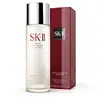SK-II Facial Treatment Essence (Pitera Essence) Versus Olay Regenerist Micro Sculpting Super Essence Water
What's inside
What's inside
 Key Ingredients
Key Ingredients

No key ingredients
 Benefits
Benefits

 Concerns
Concerns

 Ingredients Side-by-side
Ingredients Side-by-side

Water
Skin ConditioningButylene Glycol
HumectantNiacinamide
SmoothingPentylene Glycol
Skin ConditioningDipropylene Glycol
HumectantPanthenol
Skin ConditioningSodium Hyaluronate
HumectantPalmitoyl Pentapeptide-4
Skin ConditioningAloe Barbadensis Leaf Extract
EmollientCamellia Sinensis Leaf Extract
AntimicrobialTremella Fuciformis Sporocarp Extract
AntioxidantSodium PEG-7 Olive Oil Carboxylate
EmulsifyingHydrolyzed Elastin
EmollientGlycerin
HumectantGlyceryl Acrylate/Acrylic Acid Copolymer
HumectantGlycereth-25 PCA Isostearate
EmulsifyingDisodium EDTA
Pvm/Ma Copolymer
Emulsion StabilisingSodium Citrate
BufferingBenzyl Alcohol
PerfumingMethylparaben
PreservativeEthylparaben
PreservativeParfum
MaskingWater, Butylene Glycol, Niacinamide, Pentylene Glycol, Dipropylene Glycol, Panthenol, Sodium Hyaluronate, Palmitoyl Pentapeptide-4, Aloe Barbadensis Leaf Extract, Camellia Sinensis Leaf Extract, Tremella Fuciformis Sporocarp Extract, Sodium PEG-7 Olive Oil Carboxylate, Hydrolyzed Elastin, Glycerin, Glyceryl Acrylate/Acrylic Acid Copolymer, Glycereth-25 PCA Isostearate, Disodium EDTA, Pvm/Ma Copolymer, Sodium Citrate, Benzyl Alcohol, Methylparaben, Ethylparaben, Parfum
 Reviews
Reviews

Ingredients Explained
These ingredients are found in both products.
Ingredients higher up in an ingredient list are typically present in a larger amount.
Butylene Glycol (or BG) is used within cosmetic products for a few different reasons:
Overall, Butylene Glycol is a safe and well-rounded ingredient that works well with other ingredients.
Though this ingredient works well with most skin types, some people with sensitive skin may experience a reaction such as allergic rashes, closed comedones, or itchiness.
Learn more about Butylene GlycolMethylparaben is a preservative and is a paraben. It is used to prevent the growth of fungus, mold, and other harmful bacteria. Parabens are chemicals used as preservatives in both cosmetics and food.
Methylparaben can be synthetically created. It can also be found naturally in some fruits, such as blueberries.
Oftentimes, Methylparaben is combined with other parabens to help increase the shelf life.
The safety of Methylparaben is currently being studied. While ongoing studies are looking into the safety of parabens, the results have been very mixed. Some studies have not found Methylparaben to be harmful.
Learn more about MethylparabenPentylene glycol is typically used within a product to thicken it. It also adds a smooth, soft, and moisturizing feel to the product. It is naturally found in plants such as sugar beets.
The hydrophilic trait of Pentylene Glycol makes it a humectant. As a humectant, Pentylene Glycol helps draw moisture from the air to your skin. This can help keep your skin hydrated.
This property also makes Pentylene Glycol a great texture enhancer. It can also help thicken or stabilize a product.
Pentylene Glycol also acts as a mild preservative and helps to keep a product microbe-free.
Some people may experience mild eye and skin irritation from Pentylene Glycol. We always recommend speaking with a professional about using this ingredient in your routine.
Pentylene Glycol has a low molecular weight and is part of the 1,2-glycol family.
Learn more about Pentylene GlycolWater. It's the most common cosmetic ingredient of all. You'll usually see it at the top of ingredient lists, meaning that it makes up the largest part of the product.
So why is it so popular? Water most often acts as a solvent - this means that it helps dissolve other ingredients into the formulation.
You'll also recognize water as that liquid we all need to stay alive. If you see this, drink a glass of water. Stay hydrated!
Learn more about Water